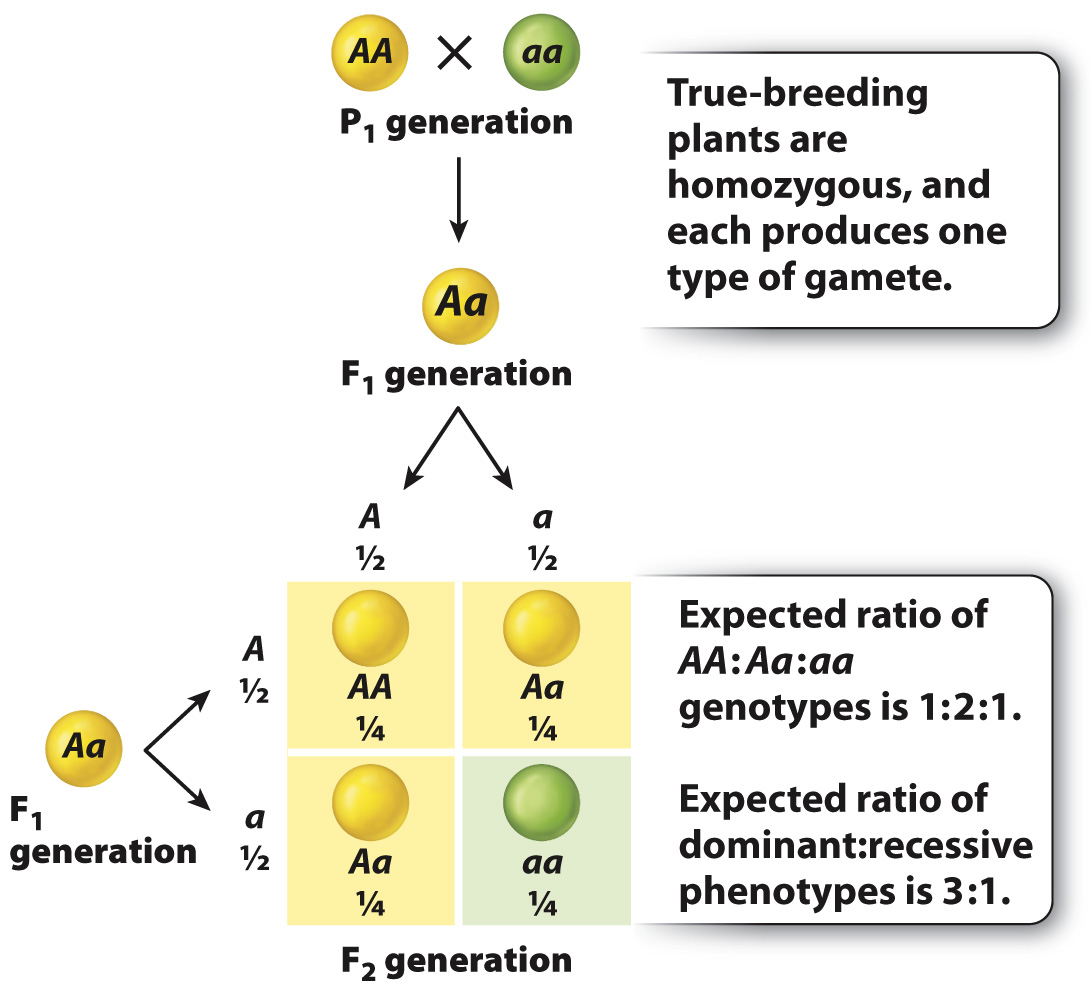Genes come in pairs that segregate in the formation of reproductive cells.

The explanation for the 3:1 ratio in the F2 and Mendel’s observations in general can be summarized with reference to Fig. 16.7:
Except for cells involved in reproduction, each cell of a pea plant contains two alleles of each gene. In each true-
breeding strain constituting the P1 generation, the two alleles are identical. In Fig. 16.7, we designate the allele associated with yellow seeds as A and that associated with green seeds as a. The genotype of the true- breeding strain with yellow seeds can therefore be written as AA, and that of the true- breeding strain with green seeds as aa. The AA and aa genotypes are said to be homozygous, which means that both alleles inherited from the parents are the same. Quick Check 1 What are the genotypes and phenotypes for Mendel’s true-
breeding parent plants? Quick Check 1 Answer
For the true-
breeding plants with yellow seeds, the phenotype is yellow seeds, and the genotype is AA. For the true- breeding plants with green seeds, the phenotype is green seeds, and the genotype is aa. Each reproductive cell, or gamete, contains only one allele of each gene. In this case, a gamete can contain the A allele or the a allele, but not both.
In the formation of gametes, the two members of a gene pair segregate (or separate) equally into gametes so that half the gametes get one allele and half get the other allele. This separation of alleles into different gametes defines the principle of segregation. In the case of homozygous plants (such as AA or aa), all the gametes from an individual are the same. That is, the homozygous AA strain with yellow seeds produces gametes containing the A allele, and the homozygous aa strain with green seeds produces gametes containing the a allele.
Page 331The fertilized egg cell, called the zygote, is formed from the random union of two gametes, one from each parent. For the cross AA × aa, the zygote is an F1 hybrid formed from the union of an A-bearing gamete with an a-
bearing gamete. Each F1 hybrid therefore has the genotype Aa (Fig. 16.7). The Aa genotype is heterozygous, which means that the two alleles for a given gene inherited from each parent are different. The seeds produced by the F1 progeny are yellow because yellow is dominant to green. Note that each F1 progeny contains an a allele because its genotype is Aa, but the phenotype of the seed is yellow and indistinguishable from that of an AA genotype. Quick Check 2 Is it possible for two individuals to have the same phenotype but different genotypes? The same genotype, but different phenotypes? How?
Quick Check 2 Answer
Yes in both cases. In the case of simple dominance, the homozygous AA and heterozygous Aa genotypes have the same phenotype but different genotypes. In traits that are influenced by the environment, individuals with the same genotype can have different phenotypes because they have different environments. An example discussed in Chapter 15 is how tobacco smoking increases the severity of emphysema resulting from the PiZ allele of the α-1 antitrypsin gene.
When the F1 progeny (genotype Aa) form gametes, by the principle of segregation the A and a alleles again separate equally so that half the gametes contain only the A allele and the other half contain only the a allele (Fig. 16.7).
In the formation of the F2 generation, the gametes from the F1 parents again combine at random. The consequences of random union of gametes can be worked out by means of a checkerboard of the sort shown at the bottom of Fig. 16.7. In this kind of square, known as a Punnett square after its inventor, the British geneticist Reginald Punnett, the gametes from each parent, each with its respective frequency, are arranged along the top and sides of a grid. Each box in the grid represents the union of the gametes in the corresponding row and column, showing all the possible genotypes of offspring that can result from random fertilization.
The boxes of the Punnett square correspond to all of the possible offspring genotypes of the F2 generation, with each possible genotype’s frequency obtained by multiplication of the gametic frequencies in the corresponding row and column. For the example illustrated in Fig. 16.7, the expected genotypes of the offspring are therefore ¼ AA, ½ Aa, and ¼ aa (or 1:2:1). When there is dominance, however, as there is in this case, the AA and Aa genotypes have the same phenotype, and so the ratio of dominant:recessive phenotypes is 3:1. The Punnett square in Fig. 16.7 illustrates the biological basis of the 3:1 ratio of phenotypes that Mendel observed in the F2 generation. Nevertheless, the underlying ratio of AA:Aa:aa genotypes is 1:2:1.
Quick Check 3 What are the expected progeny (genotypes and phenotypes) from a cross of an AA plant with an Aa plant?
Quick Check 3 Answer
Half the progeny will have the AA genotype and half will have the Aa genotype. All the plants will have yellow seeds.